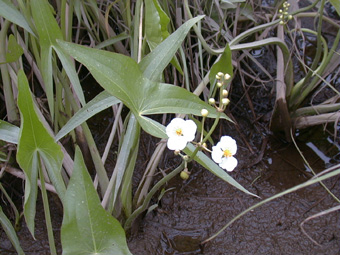
General Species Description
- A native rooted aquatic to emergent perennial herb with tuber producing rhizomes. This species grows from a rosette of basal leaves with numerous stolons and rhizomes. The plant spreads, forming large stands in areas of slow moving or stagnant water. Sagittaria latifolia can reach 90 cm in height.
Leaves
- Basal, stalks are long and angled in cross-section, sheathing at base. The leaf blades above water are arrow-shaped (about 25 cm long and 20 cm wide) while the submerged leaves are lance-shaped or bladeless (4-10 mm wide) and linear. Submerged leaves grow in a cluster from a single tuber-like base.
Inflorescence/Flowers
- Large white flowers (1-2 cm), with sexes occurring on separate flowers; 3 greenish sepals; 3 petals which fall off early. Numerous ovaries and stamens are present. The flower occurs in several whorls of 3 (2-8 per node) in a long, narrow terminal cluster. Sagittaria latifolia blooms from July through September.
Fruits
- Clustered, winged achenes that are oblong, flattened, with sharp beak, 0.5 -1.5 cm long.
Habitat
- Sagittaria latifolia can readily be found in emergent marshes, ponds, lakes, sloughs, lagoons, and wet ditches. Restricted to low elevations.
Range
- This plant is fairly common along the Columbia River west of the Columbia Gorge abd through the Willamette Valley. Infrequently found in most of western Washington. Grows abundantly in eastern and central United States, south through Mexico and Central America to northern South America, in the West Indies, and Hawaii. Sagittaria latifolia is generally associated with Juncus (rushes), Carex, and Typha species, and with Alopecurus geniculatus (water foxtail).
Similar Species
- Menyanthes trifoliata (Bogbean), Balsamorhiza deltoidea (Deltoid balsamroot), Balsamorhiza sagittata (Arrow-leaf balsamroot). However, balsamroots do not grow well in inundated or saturated conditions.
Ecological Value
- Tubers are planted extensively to restore and create wetlands. They provide food for many waterfowl, shorebirds, and geese. Beaver, porcupine, and muskrat consume the entire plant, while Canadian Geese are partial to the tubers. This species has been used in wastewater treatment systems for the removal of dissolved nutrients.
Human Value
- Known as the "delta potato", the tubers are edible when boiled or roasted. Many North American Natives have used the tubers as a staple food. Lewis and Clark and many, early European settlers ate the tubers. The tubers are also harvested and used in cooking in Japan and China.
References
- Pojar, J. and MacKinnon, A., Plants of the Pacific Northwest Coast, 1994. Cooke, S.S., A Field Guide to the Common Wetland Plants of Western Washington and Northwestern Oregon, 1997. Guard, B. J., Wetland Plants of Oregon and Washington, 1995.
This page was created by: Michelle Michaud, August 1999
Return to Northwest Oregon
Wetland Plants Project